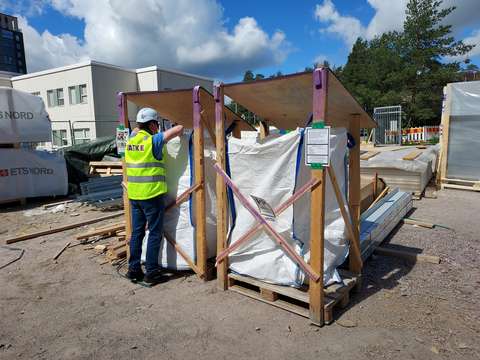Recycling installation waste – pilot project at Espoonlahti Health Centre construction site encourages continuation

During the pilot, about 7% of new pipes ended up as installation waste. Thanks to the pilot project, most of this waste was successfully recycled into new products.
Trial and learn
Plastic is a great building material due to its light weight and durability, but recycling construction plastics remains a challenge. Various types of plastic waste are generated at construction sites, and one specific type caught the attention of the Closed Plastic Circle – from Pilots into Practice project: could installation waste produced during the installation of new pipes be collected and recycled into new products?
Installation waste arises when pipes delivered to the site are cut to size, leaving offcuts that cannot be utilised on-site. In theory, clean and intact pipe offcuts are highly suitable for recycling. However, before practical trials, there was no certainty about how much offcut waste was generated, how challenging sorting would be, or if any unforeseen issues would arise during reprocessing.
The renovation project of the Espoonlahti Health Centre presented an ideal opportunity for a trial. Together with construction contractor Jatke and pipe manufacturer Meltex, we put the plan into action.
Reusable raw material
The collection of installation waste at Jatke’s construction site was highly successful. The pipes were collected into bags, which made it easy to toss in the offcuts. The bags were also placed close to the mixed waste area, making collection convenient for workers. At the start of the trial, the health centre’s sewage pipes had already been installed, so the pipes collected in the bags were mainly stormwater, drainage and cable pipes. A total of 1,426 kilograms of these pipes were delivered to the site, with 145 kg collected as waste, resulting in about 7% installation waste.
The collected pipe offcuts were transported to the circular economy lab of the project partner, LAB University of Applied Sciences, for processing. After FTIR spectroscopy to identify the materials, they were cleaned and shredded. Most of the plastics were either polyethylene (PE) or polypropylene (PP).
A total of 99 kilograms of processed installation waste suitable for new products was delivered to Meltex’s pipe factory. This quantity represents about 69% of the collected 7% installation waste. Generally, recycled pipes are ideal for products that do not require weldability. PP fractions can, for example, be used to produce sleeve pipes for filter fabrics – approximately 29 metres of finished sleeve pipe can be made from the collected quantity. PE, on the other hand, can be utilised in blends to manufacture telescopic pipes.
Scaling up requires further actions
The pilot confirmed that collecting installation waste and recycling it into new products is a highly viable and potentially scalable practice.
“Processing costs are not a major concern for pipe fractions that are well-suited to mechanical recycling and reuse. The main challenge is obtaining sufficient quantities of recyclable fractions for reprocessing – recycling equipment solutions are generally designed for high volumes,” says Kimmo Virtanen from Meltex.
Moreover, scaling up similar trials is hindered by current waste legislation, which classifies installation waste as waste, requiring collectors to hold an environmental permit for waste processing. This calls for proactive efforts from both on-site waste sorters and legislators.
“Using a carefully manufactured plastic pipe in a building only to incinerate it afterward is like buying a new car, driving it from Kalasatama to Soukka, and then taking it to a scrapyard. It just makes no sense,” Virtanen adds.
“Espoo wants to promote companies’ new innovations by providing platforms for various trials. We encourage municipalities to boldly collaborate with contractors and building product manufacturers on similar circular economy experiments,” says Tiia Tuuri, Development Manager at the City of Espoo, who continues to promote circular construction across the Helsinki Metropolitan Area in the new “Kiertotalot” (“Circular Housing”) project.